Business Environment: Analysis of Tesco and Organizational Functions
VerifiedAdded on 2020/12/29
|15
|3330
|209
Report
AI Summary
This report provides an overview of different types of organizations, including public, private, and voluntary organizations, outlining their objectives, financing, legal structures, and key stakeholders. It then focuses on a case study of Tesco, a multinational retailer, examining its size, scope, and the interrelationship of various functions within the organization, such as operations management, supply chain management, marketing & sales, human resource management, and financial management. The report highlights the impact of globalization on Tesco's operations, including increased scale, access to global supply chains, and heightened competition. It also discusses the strategic relationships between different organizational functions, the importance of financial management, human resource diversity, and the need for ethical practices and compliance with anti-discrimination laws. The report concludes with recommendations for Tesco, including identifying new international markets and enhancing ethical practices within its human resource function to effectively manage a diverse workforce in a competitive global environment. This report offers valuable insights into the complexities of organizational structures and their adaptation to the challenges and opportunities of the global business environment.
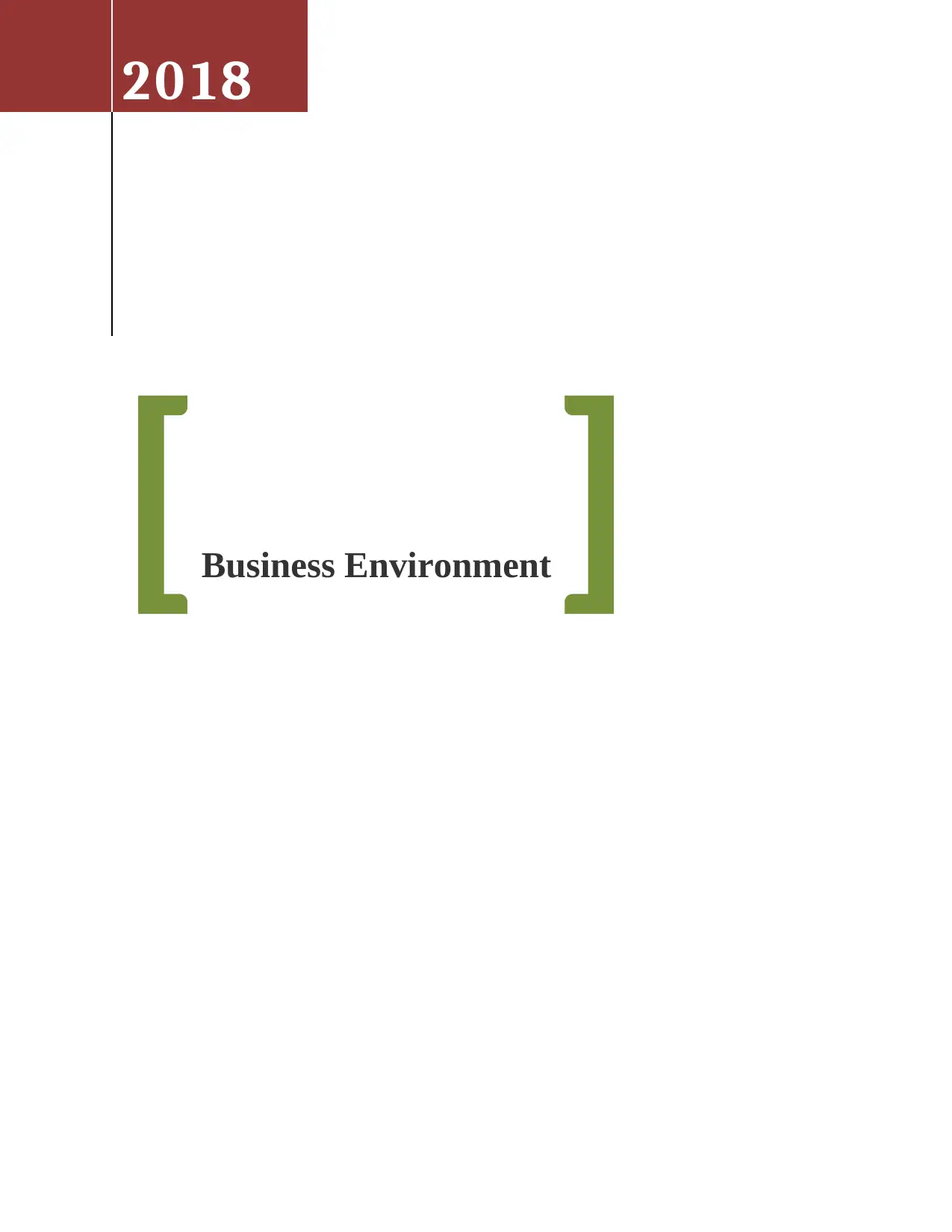
[Business Environment]
2018
2018
Paraphrase This Document
Need a fresh take? Get an instant paraphrase of this document with our AI Paraphraser
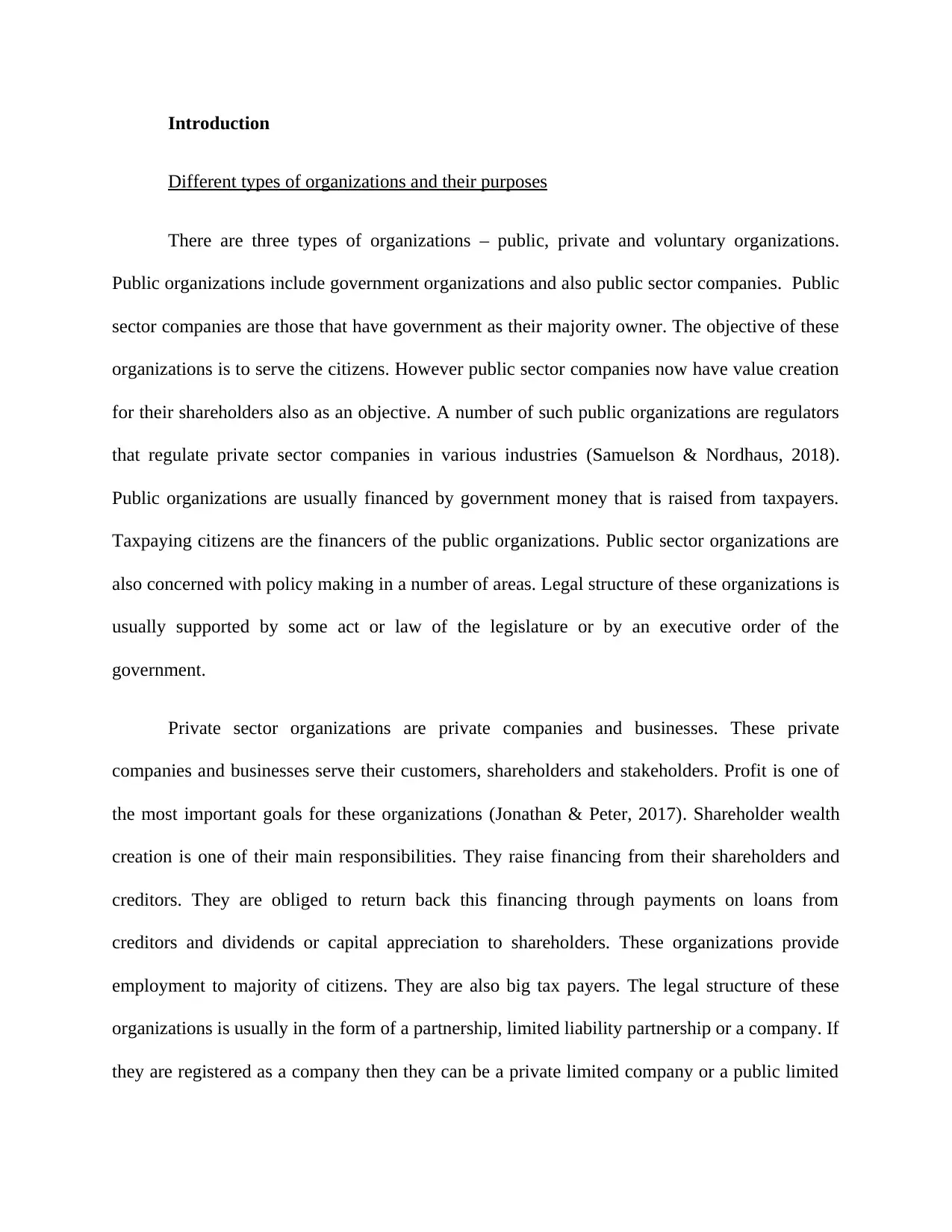
Introduction
Different types of organizations and their purposes
There are three types of organizations – public, private and voluntary organizations.
Public organizations include government organizations and also public sector companies. Public
sector companies are those that have government as their majority owner. The objective of these
organizations is to serve the citizens. However public sector companies now have value creation
for their shareholders also as an objective. A number of such public organizations are regulators
that regulate private sector companies in various industries (Samuelson & Nordhaus, 2018).
Public organizations are usually financed by government money that is raised from taxpayers.
Taxpaying citizens are the financers of the public organizations. Public sector organizations are
also concerned with policy making in a number of areas. Legal structure of these organizations is
usually supported by some act or law of the legislature or by an executive order of the
government.
Private sector organizations are private companies and businesses. These private
companies and businesses serve their customers, shareholders and stakeholders. Profit is one of
the most important goals for these organizations (Jonathan & Peter, 2017). Shareholder wealth
creation is one of their main responsibilities. They raise financing from their shareholders and
creditors. They are obliged to return back this financing through payments on loans from
creditors and dividends or capital appreciation to shareholders. These organizations provide
employment to majority of citizens. They are also big tax payers. The legal structure of these
organizations is usually in the form of a partnership, limited liability partnership or a company. If
they are registered as a company then they can be a private limited company or a public limited
Different types of organizations and their purposes
There are three types of organizations – public, private and voluntary organizations.
Public organizations include government organizations and also public sector companies. Public
sector companies are those that have government as their majority owner. The objective of these
organizations is to serve the citizens. However public sector companies now have value creation
for their shareholders also as an objective. A number of such public organizations are regulators
that regulate private sector companies in various industries (Samuelson & Nordhaus, 2018).
Public organizations are usually financed by government money that is raised from taxpayers.
Taxpaying citizens are the financers of the public organizations. Public sector organizations are
also concerned with policy making in a number of areas. Legal structure of these organizations is
usually supported by some act or law of the legislature or by an executive order of the
government.
Private sector organizations are private companies and businesses. These private
companies and businesses serve their customers, shareholders and stakeholders. Profit is one of
the most important goals for these organizations (Jonathan & Peter, 2017). Shareholder wealth
creation is one of their main responsibilities. They raise financing from their shareholders and
creditors. They are obliged to return back this financing through payments on loans from
creditors and dividends or capital appreciation to shareholders. These organizations provide
employment to majority of citizens. They are also big tax payers. The legal structure of these
organizations is usually in the form of a partnership, limited liability partnership or a company. If
they are registered as a company then they can be a private limited company or a public limited
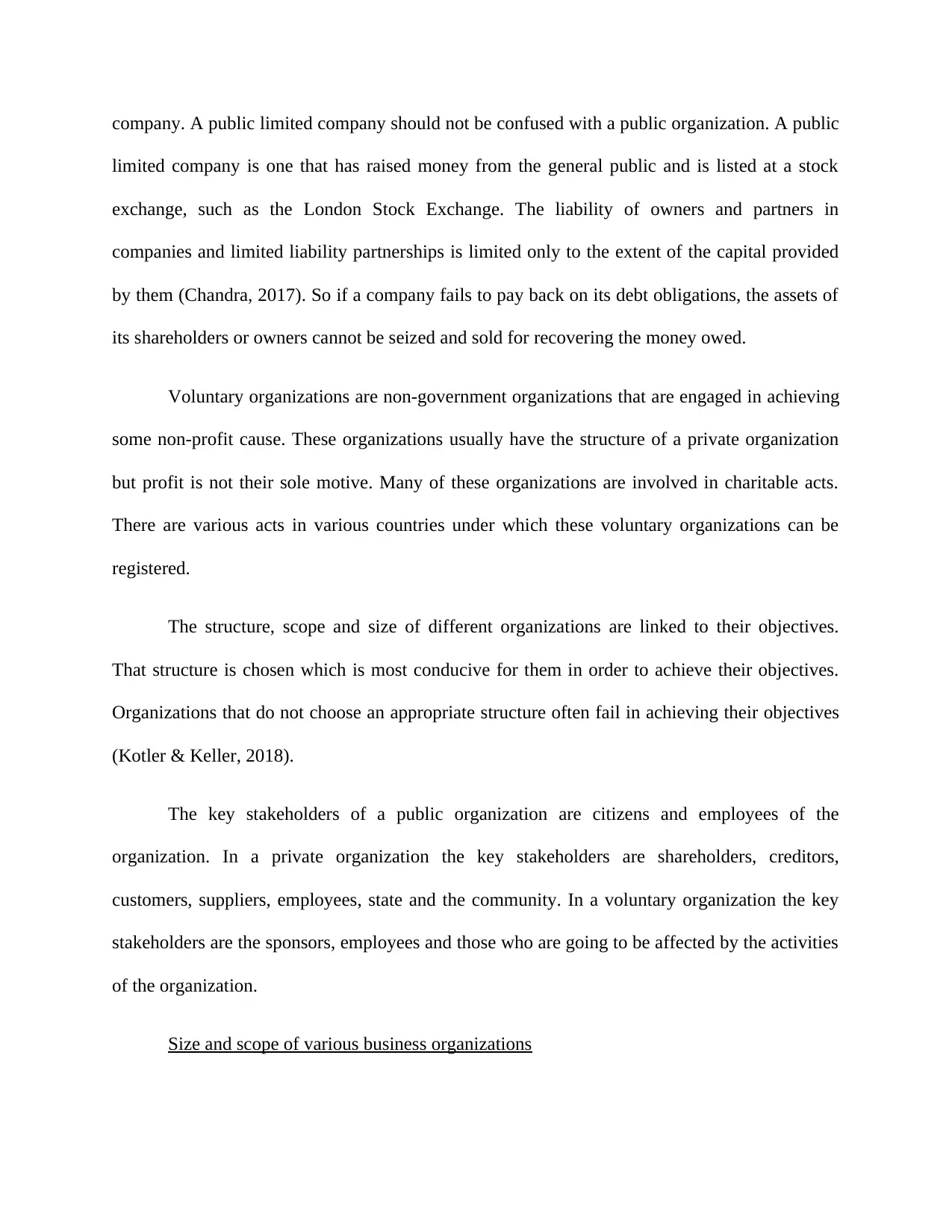
company. A public limited company should not be confused with a public organization. A public
limited company is one that has raised money from the general public and is listed at a stock
exchange, such as the London Stock Exchange. The liability of owners and partners in
companies and limited liability partnerships is limited only to the extent of the capital provided
by them (Chandra, 2017). So if a company fails to pay back on its debt obligations, the assets of
its shareholders or owners cannot be seized and sold for recovering the money owed.
Voluntary organizations are non-government organizations that are engaged in achieving
some non-profit cause. These organizations usually have the structure of a private organization
but profit is not their sole motive. Many of these organizations are involved in charitable acts.
There are various acts in various countries under which these voluntary organizations can be
registered.
The structure, scope and size of different organizations are linked to their objectives.
That structure is chosen which is most conducive for them in order to achieve their objectives.
Organizations that do not choose an appropriate structure often fail in achieving their objectives
(Kotler & Keller, 2018).
The key stakeholders of a public organization are citizens and employees of the
organization. In a private organization the key stakeholders are shareholders, creditors,
customers, suppliers, employees, state and the community. In a voluntary organization the key
stakeholders are the sponsors, employees and those who are going to be affected by the activities
of the organization.
Size and scope of various business organizations
limited company is one that has raised money from the general public and is listed at a stock
exchange, such as the London Stock Exchange. The liability of owners and partners in
companies and limited liability partnerships is limited only to the extent of the capital provided
by them (Chandra, 2017). So if a company fails to pay back on its debt obligations, the assets of
its shareholders or owners cannot be seized and sold for recovering the money owed.
Voluntary organizations are non-government organizations that are engaged in achieving
some non-profit cause. These organizations usually have the structure of a private organization
but profit is not their sole motive. Many of these organizations are involved in charitable acts.
There are various acts in various countries under which these voluntary organizations can be
registered.
The structure, scope and size of different organizations are linked to their objectives.
That structure is chosen which is most conducive for them in order to achieve their objectives.
Organizations that do not choose an appropriate structure often fail in achieving their objectives
(Kotler & Keller, 2018).
The key stakeholders of a public organization are citizens and employees of the
organization. In a private organization the key stakeholders are shareholders, creditors,
customers, suppliers, employees, state and the community. In a voluntary organization the key
stakeholders are the sponsors, employees and those who are going to be affected by the activities
of the organization.
Size and scope of various business organizations
⊘ This is a preview!⊘
Do you want full access?
Subscribe today to unlock all pages.

Trusted by 1+ million students worldwide
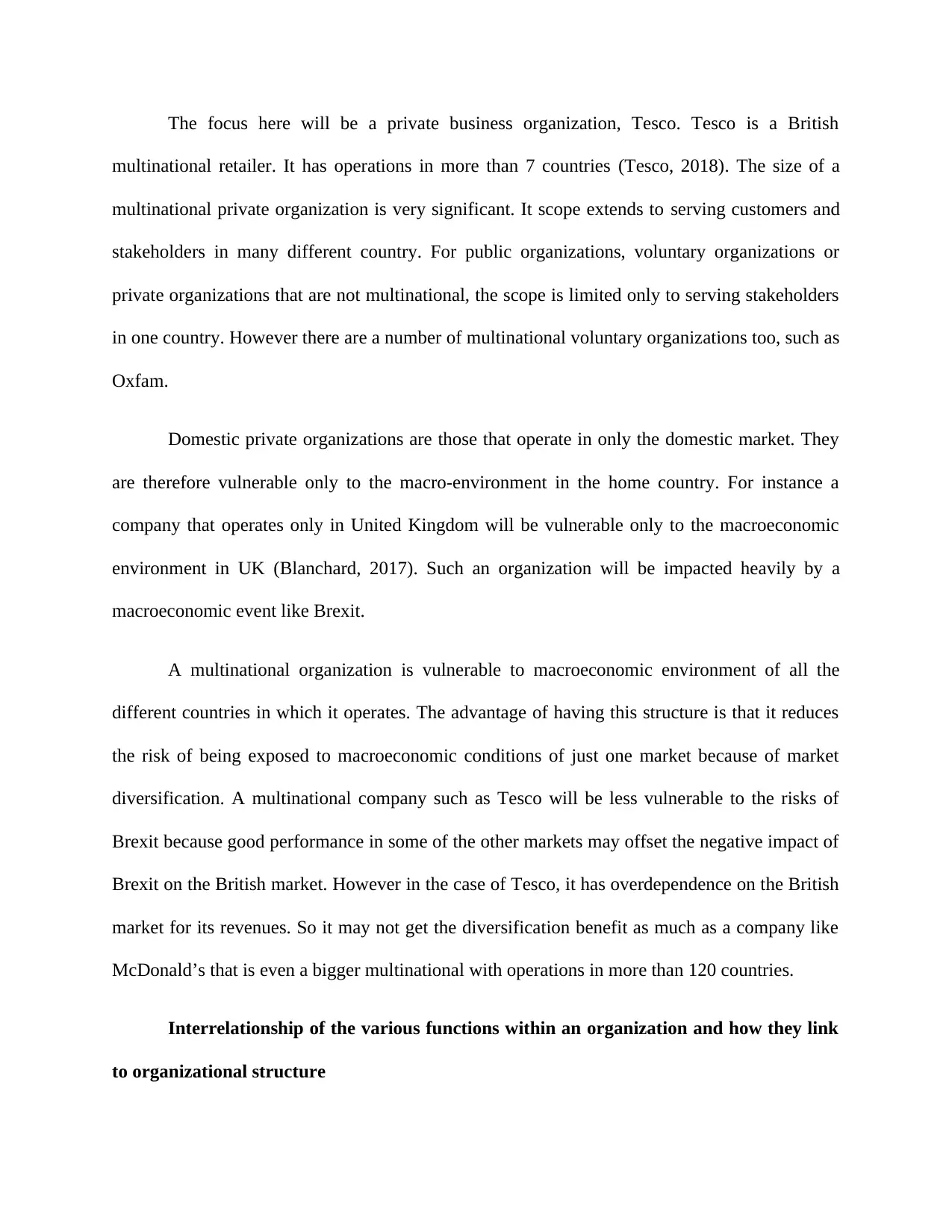
The focus here will be a private business organization, Tesco. Tesco is a British
multinational retailer. It has operations in more than 7 countries (Tesco, 2018). The size of a
multinational private organization is very significant. It scope extends to serving customers and
stakeholders in many different country. For public organizations, voluntary organizations or
private organizations that are not multinational, the scope is limited only to serving stakeholders
in one country. However there are a number of multinational voluntary organizations too, such as
Oxfam.
Domestic private organizations are those that operate in only the domestic market. They
are therefore vulnerable only to the macro-environment in the home country. For instance a
company that operates only in United Kingdom will be vulnerable only to the macroeconomic
environment in UK (Blanchard, 2017). Such an organization will be impacted heavily by a
macroeconomic event like Brexit.
A multinational organization is vulnerable to macroeconomic environment of all the
different countries in which it operates. The advantage of having this structure is that it reduces
the risk of being exposed to macroeconomic conditions of just one market because of market
diversification. A multinational company such as Tesco will be less vulnerable to the risks of
Brexit because good performance in some of the other markets may offset the negative impact of
Brexit on the British market. However in the case of Tesco, it has overdependence on the British
market for its revenues. So it may not get the diversification benefit as much as a company like
McDonald’s that is even a bigger multinational with operations in more than 120 countries.
Interrelationship of the various functions within an organization and how they link
to organizational structure
multinational retailer. It has operations in more than 7 countries (Tesco, 2018). The size of a
multinational private organization is very significant. It scope extends to serving customers and
stakeholders in many different country. For public organizations, voluntary organizations or
private organizations that are not multinational, the scope is limited only to serving stakeholders
in one country. However there are a number of multinational voluntary organizations too, such as
Oxfam.
Domestic private organizations are those that operate in only the domestic market. They
are therefore vulnerable only to the macro-environment in the home country. For instance a
company that operates only in United Kingdom will be vulnerable only to the macroeconomic
environment in UK (Blanchard, 2017). Such an organization will be impacted heavily by a
macroeconomic event like Brexit.
A multinational organization is vulnerable to macroeconomic environment of all the
different countries in which it operates. The advantage of having this structure is that it reduces
the risk of being exposed to macroeconomic conditions of just one market because of market
diversification. A multinational company such as Tesco will be less vulnerable to the risks of
Brexit because good performance in some of the other markets may offset the negative impact of
Brexit on the British market. However in the case of Tesco, it has overdependence on the British
market for its revenues. So it may not get the diversification benefit as much as a company like
McDonald’s that is even a bigger multinational with operations in more than 120 countries.
Interrelationship of the various functions within an organization and how they link
to organizational structure
Paraphrase This Document
Need a fresh take? Get an instant paraphrase of this document with our AI Paraphraser
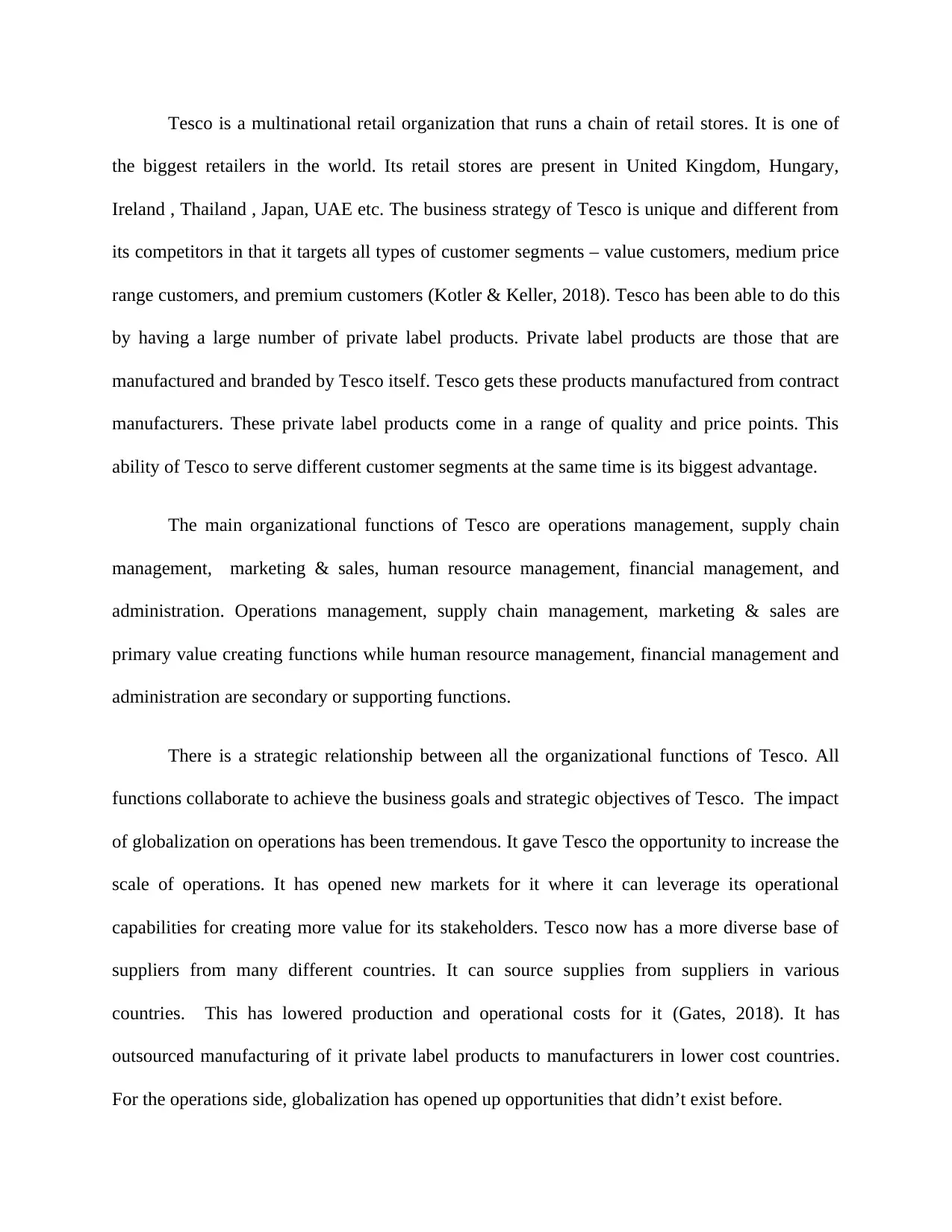
Tesco is a multinational retail organization that runs a chain of retail stores. It is one of
the biggest retailers in the world. Its retail stores are present in United Kingdom, Hungary,
Ireland , Thailand , Japan, UAE etc. The business strategy of Tesco is unique and different from
its competitors in that it targets all types of customer segments – value customers, medium price
range customers, and premium customers (Kotler & Keller, 2018). Tesco has been able to do this
by having a large number of private label products. Private label products are those that are
manufactured and branded by Tesco itself. Tesco gets these products manufactured from contract
manufacturers. These private label products come in a range of quality and price points. This
ability of Tesco to serve different customer segments at the same time is its biggest advantage.
The main organizational functions of Tesco are operations management, supply chain
management, marketing & sales, human resource management, financial management, and
administration. Operations management, supply chain management, marketing & sales are
primary value creating functions while human resource management, financial management and
administration are secondary or supporting functions.
There is a strategic relationship between all the organizational functions of Tesco. All
functions collaborate to achieve the business goals and strategic objectives of Tesco. The impact
of globalization on operations has been tremendous. It gave Tesco the opportunity to increase the
scale of operations. It has opened new markets for it where it can leverage its operational
capabilities for creating more value for its stakeholders. Tesco now has a more diverse base of
suppliers from many different countries. It can source supplies from suppliers in various
countries. This has lowered production and operational costs for it (Gates, 2018). It has
outsourced manufacturing of it private label products to manufacturers in lower cost countries.
For the operations side, globalization has opened up opportunities that didn’t exist before.
the biggest retailers in the world. Its retail stores are present in United Kingdom, Hungary,
Ireland , Thailand , Japan, UAE etc. The business strategy of Tesco is unique and different from
its competitors in that it targets all types of customer segments – value customers, medium price
range customers, and premium customers (Kotler & Keller, 2018). Tesco has been able to do this
by having a large number of private label products. Private label products are those that are
manufactured and branded by Tesco itself. Tesco gets these products manufactured from contract
manufacturers. These private label products come in a range of quality and price points. This
ability of Tesco to serve different customer segments at the same time is its biggest advantage.
The main organizational functions of Tesco are operations management, supply chain
management, marketing & sales, human resource management, financial management, and
administration. Operations management, supply chain management, marketing & sales are
primary value creating functions while human resource management, financial management and
administration are secondary or supporting functions.
There is a strategic relationship between all the organizational functions of Tesco. All
functions collaborate to achieve the business goals and strategic objectives of Tesco. The impact
of globalization on operations has been tremendous. It gave Tesco the opportunity to increase the
scale of operations. It has opened new markets for it where it can leverage its operational
capabilities for creating more value for its stakeholders. Tesco now has a more diverse base of
suppliers from many different countries. It can source supplies from suppliers in various
countries. This has lowered production and operational costs for it (Gates, 2018). It has
outsourced manufacturing of it private label products to manufacturers in lower cost countries.
For the operations side, globalization has opened up opportunities that didn’t exist before.
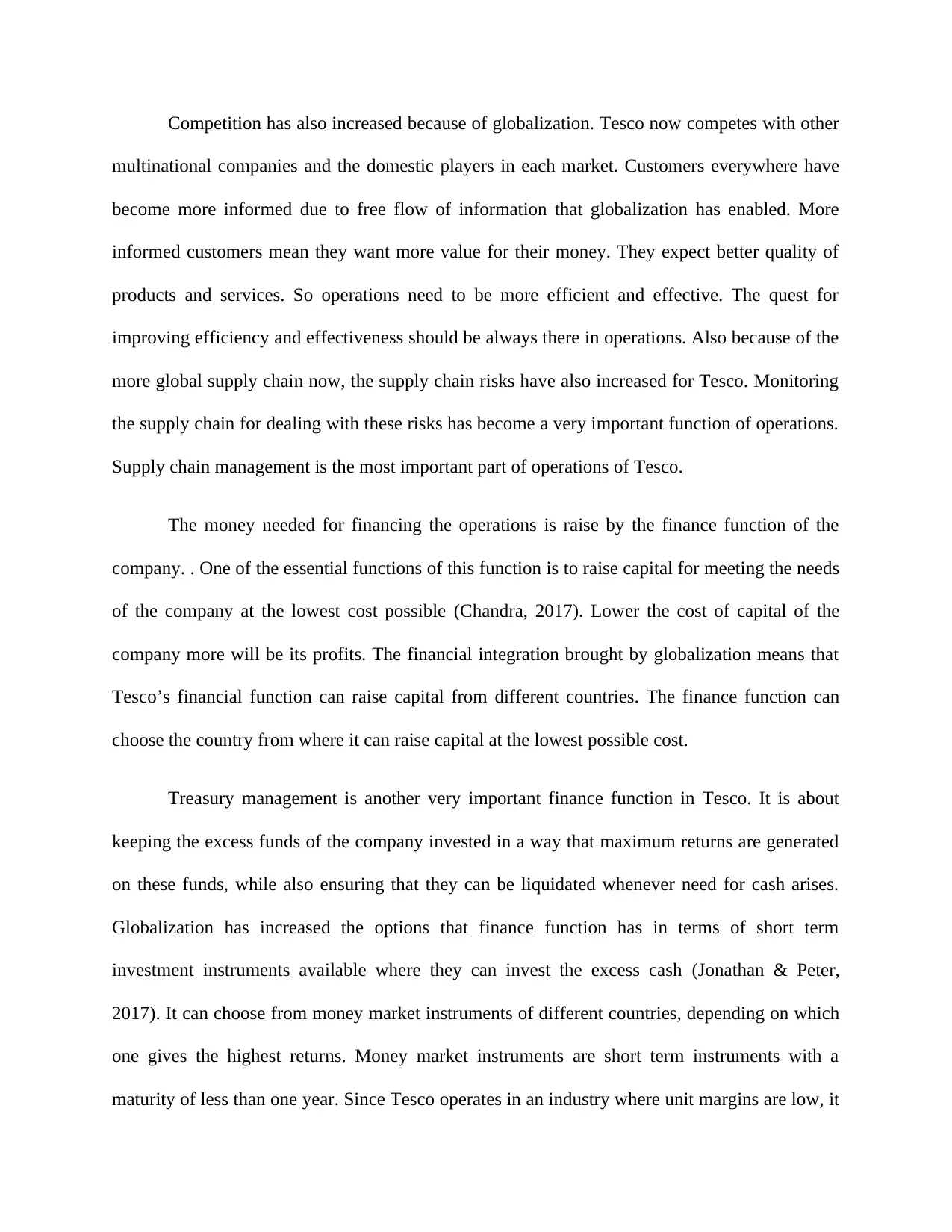
Competition has also increased because of globalization. Tesco now competes with other
multinational companies and the domestic players in each market. Customers everywhere have
become more informed due to free flow of information that globalization has enabled. More
informed customers mean they want more value for their money. They expect better quality of
products and services. So operations need to be more efficient and effective. The quest for
improving efficiency and effectiveness should be always there in operations. Also because of the
more global supply chain now, the supply chain risks have also increased for Tesco. Monitoring
the supply chain for dealing with these risks has become a very important function of operations.
Supply chain management is the most important part of operations of Tesco.
The money needed for financing the operations is raise by the finance function of the
company. . One of the essential functions of this function is to raise capital for meeting the needs
of the company at the lowest cost possible (Chandra, 2017). Lower the cost of capital of the
company more will be its profits. The financial integration brought by globalization means that
Tesco’s financial function can raise capital from different countries. The finance function can
choose the country from where it can raise capital at the lowest possible cost.
Treasury management is another very important finance function in Tesco. It is about
keeping the excess funds of the company invested in a way that maximum returns are generated
on these funds, while also ensuring that they can be liquidated whenever need for cash arises.
Globalization has increased the options that finance function has in terms of short term
investment instruments available where they can invest the excess cash (Jonathan & Peter,
2017). It can choose from money market instruments of different countries, depending on which
one gives the highest returns. Money market instruments are short term instruments with a
maturity of less than one year. Since Tesco operates in an industry where unit margins are low, it
multinational companies and the domestic players in each market. Customers everywhere have
become more informed due to free flow of information that globalization has enabled. More
informed customers mean they want more value for their money. They expect better quality of
products and services. So operations need to be more efficient and effective. The quest for
improving efficiency and effectiveness should be always there in operations. Also because of the
more global supply chain now, the supply chain risks have also increased for Tesco. Monitoring
the supply chain for dealing with these risks has become a very important function of operations.
Supply chain management is the most important part of operations of Tesco.
The money needed for financing the operations is raise by the finance function of the
company. . One of the essential functions of this function is to raise capital for meeting the needs
of the company at the lowest cost possible (Chandra, 2017). Lower the cost of capital of the
company more will be its profits. The financial integration brought by globalization means that
Tesco’s financial function can raise capital from different countries. The finance function can
choose the country from where it can raise capital at the lowest possible cost.
Treasury management is another very important finance function in Tesco. It is about
keeping the excess funds of the company invested in a way that maximum returns are generated
on these funds, while also ensuring that they can be liquidated whenever need for cash arises.
Globalization has increased the options that finance function has in terms of short term
investment instruments available where they can invest the excess cash (Jonathan & Peter,
2017). It can choose from money market instruments of different countries, depending on which
one gives the highest returns. Money market instruments are short term instruments with a
maturity of less than one year. Since Tesco operates in an industry where unit margins are low, it
⊘ This is a preview!⊘
Do you want full access?
Subscribe today to unlock all pages.

Trusted by 1+ million students worldwide
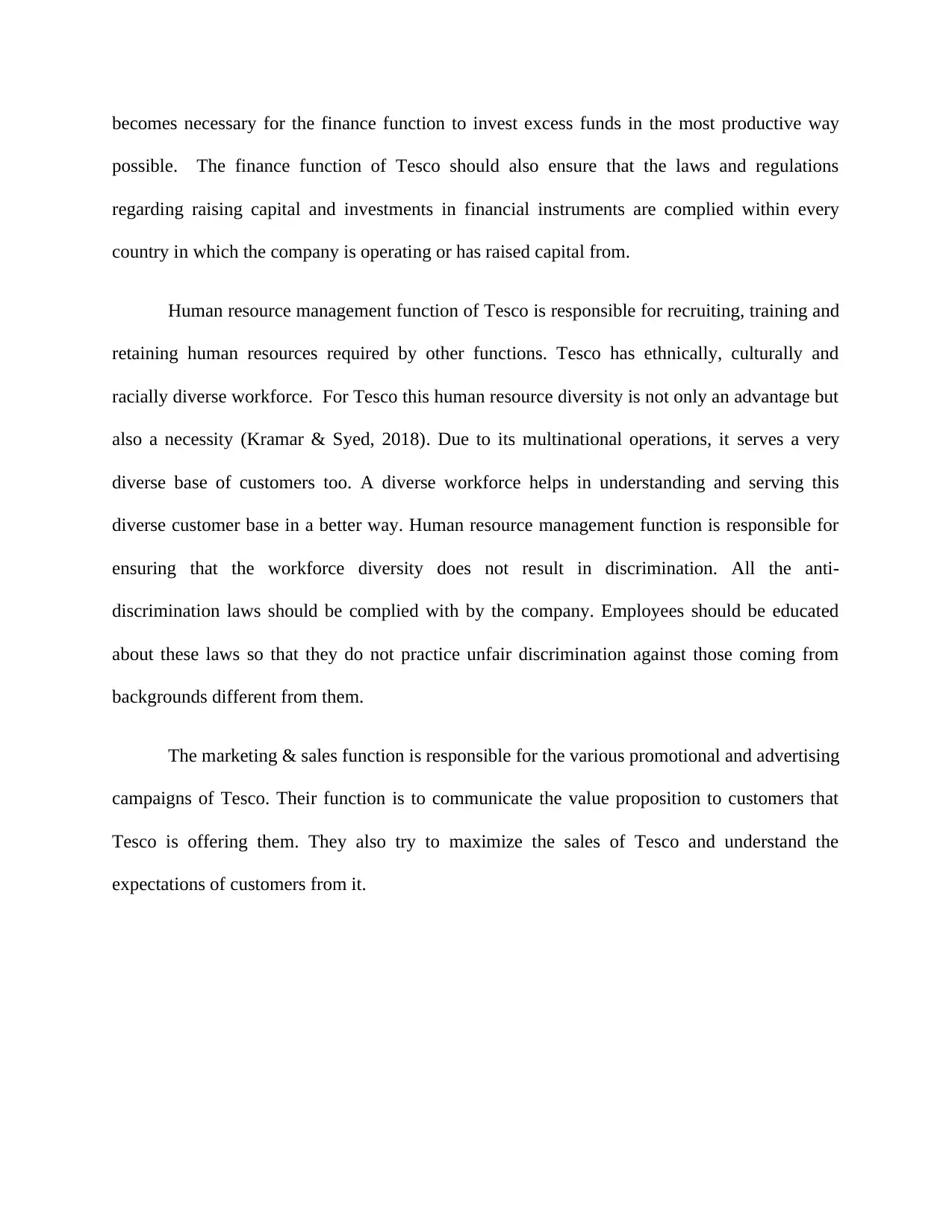
becomes necessary for the finance function to invest excess funds in the most productive way
possible. The finance function of Tesco should also ensure that the laws and regulations
regarding raising capital and investments in financial instruments are complied within every
country in which the company is operating or has raised capital from.
Human resource management function of Tesco is responsible for recruiting, training and
retaining human resources required by other functions. Tesco has ethnically, culturally and
racially diverse workforce. For Tesco this human resource diversity is not only an advantage but
also a necessity (Kramar & Syed, 2018). Due to its multinational operations, it serves a very
diverse base of customers too. A diverse workforce helps in understanding and serving this
diverse customer base in a better way. Human resource management function is responsible for
ensuring that the workforce diversity does not result in discrimination. All the anti-
discrimination laws should be complied with by the company. Employees should be educated
about these laws so that they do not practice unfair discrimination against those coming from
backgrounds different from them.
The marketing & sales function is responsible for the various promotional and advertising
campaigns of Tesco. Their function is to communicate the value proposition to customers that
Tesco is offering them. They also try to maximize the sales of Tesco and understand the
expectations of customers from it.
possible. The finance function of Tesco should also ensure that the laws and regulations
regarding raising capital and investments in financial instruments are complied within every
country in which the company is operating or has raised capital from.
Human resource management function of Tesco is responsible for recruiting, training and
retaining human resources required by other functions. Tesco has ethnically, culturally and
racially diverse workforce. For Tesco this human resource diversity is not only an advantage but
also a necessity (Kramar & Syed, 2018). Due to its multinational operations, it serves a very
diverse base of customers too. A diverse workforce helps in understanding and serving this
diverse customer base in a better way. Human resource management function is responsible for
ensuring that the workforce diversity does not result in discrimination. All the anti-
discrimination laws should be complied with by the company. Employees should be educated
about these laws so that they do not practice unfair discrimination against those coming from
backgrounds different from them.
The marketing & sales function is responsible for the various promotional and advertising
campaigns of Tesco. Their function is to communicate the value proposition to customers that
Tesco is offering them. They also try to maximize the sales of Tesco and understand the
expectations of customers from it.
Paraphrase This Document
Need a fresh take? Get an instant paraphrase of this document with our AI Paraphraser
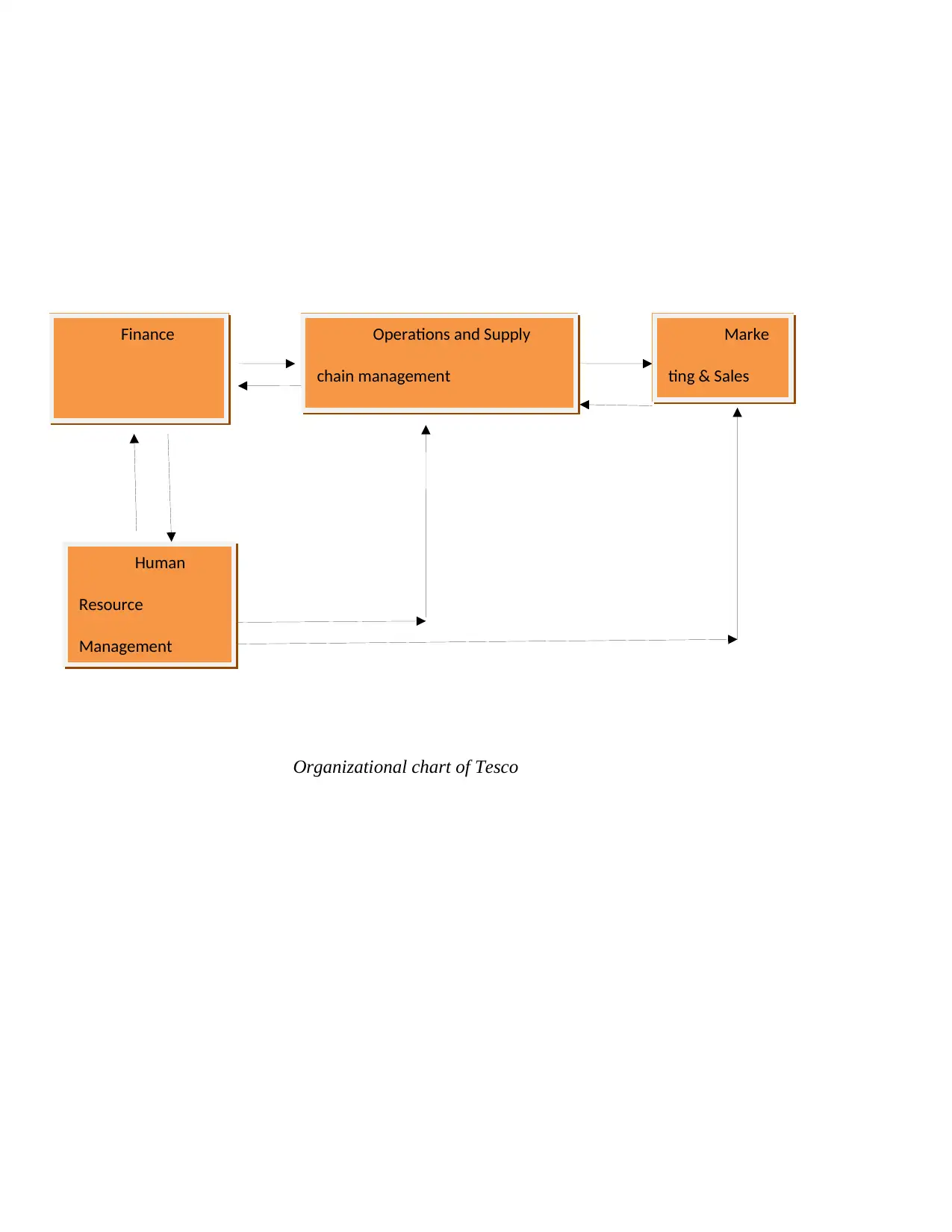
Organizational chart of Tesco
Operations and Supply
chain management
Finance
Human
Resource
Management
Marke
ting & Sales
Operations and Supply
chain management
Finance
Human
Resource
Management
Marke
ting & Sales
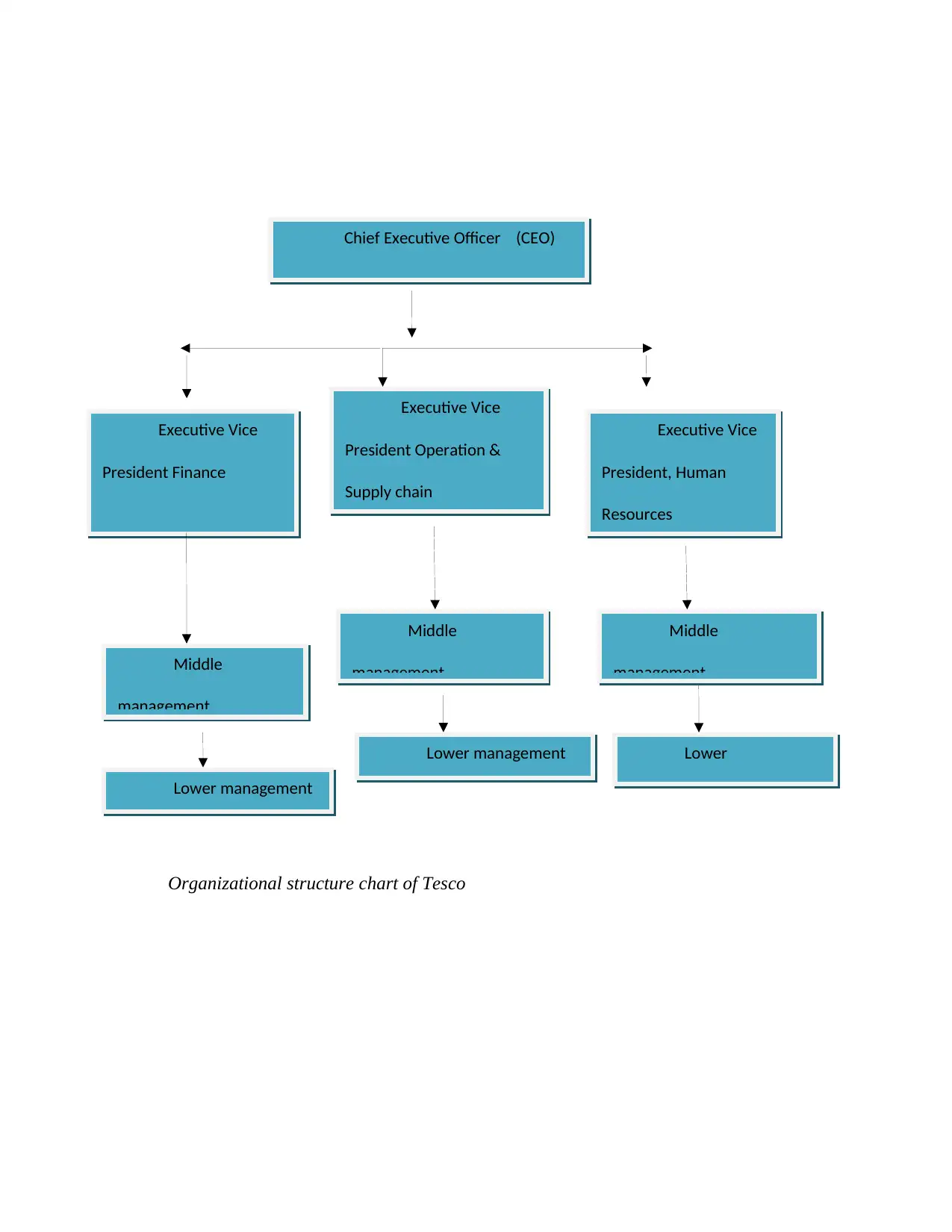
Organizational structure chart of Tesco
Chief Executive Officer (CEO)
Executive Vice
President Finance
Executive Vice
President Operation &
Supply chain
Executive Vice
President, Human
Resources
Middle
management
Lower management
Middle
management
Lower management
Middle
management
Lower
management
Chief Executive Officer (CEO)
Executive Vice
President Finance
Executive Vice
President Operation &
Supply chain
Executive Vice
President, Human
Resources
Middle
management
Lower management
Middle
management
Lower management
Middle
management
Lower
management
⊘ This is a preview!⊘
Do you want full access?
Subscribe today to unlock all pages.

Trusted by 1+ million students worldwide
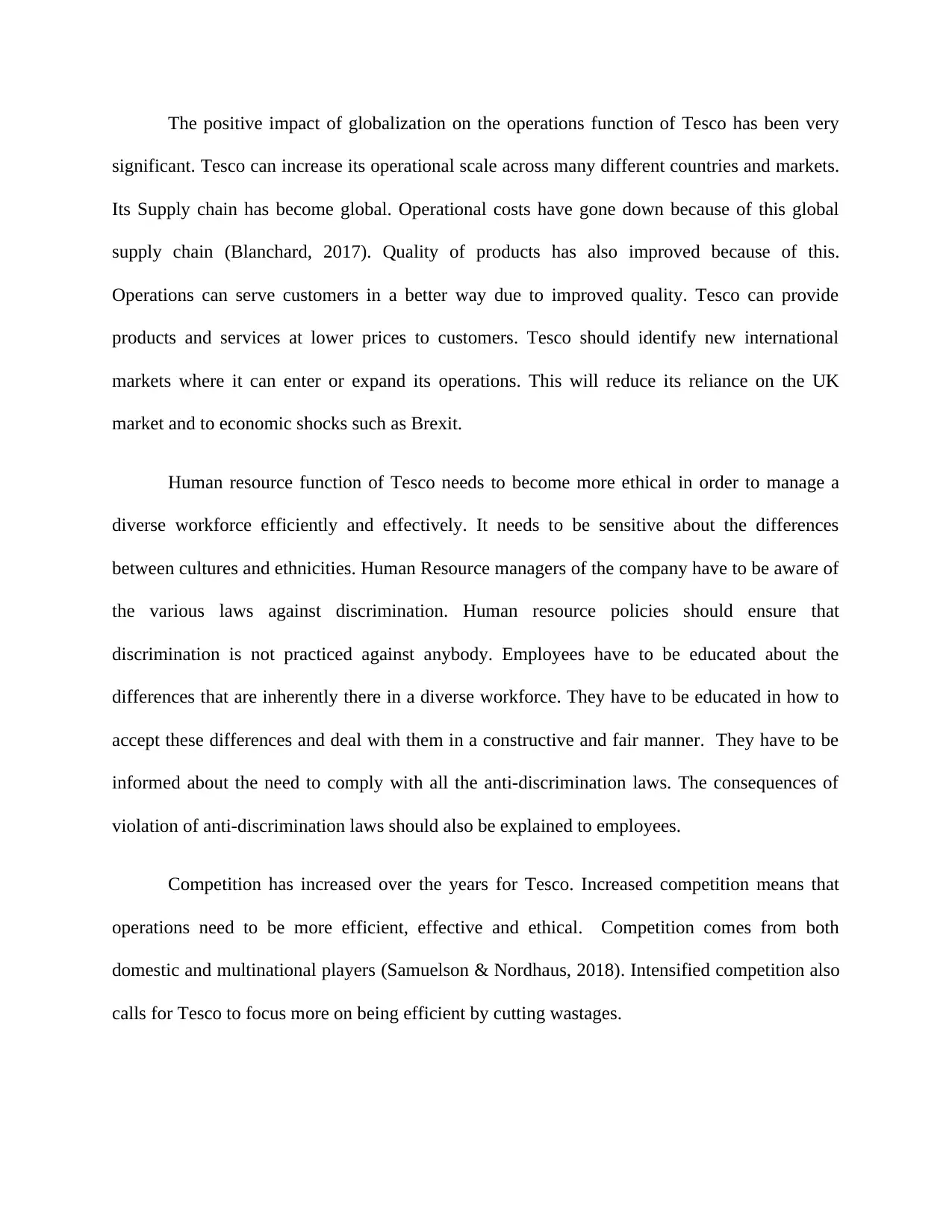
The positive impact of globalization on the operations function of Tesco has been very
significant. Tesco can increase its operational scale across many different countries and markets.
Its Supply chain has become global. Operational costs have gone down because of this global
supply chain (Blanchard, 2017). Quality of products has also improved because of this.
Operations can serve customers in a better way due to improved quality. Tesco can provide
products and services at lower prices to customers. Tesco should identify new international
markets where it can enter or expand its operations. This will reduce its reliance on the UK
market and to economic shocks such as Brexit.
Human resource function of Tesco needs to become more ethical in order to manage a
diverse workforce efficiently and effectively. It needs to be sensitive about the differences
between cultures and ethnicities. Human Resource managers of the company have to be aware of
the various laws against discrimination. Human resource policies should ensure that
discrimination is not practiced against anybody. Employees have to be educated about the
differences that are inherently there in a diverse workforce. They have to be educated in how to
accept these differences and deal with them in a constructive and fair manner. They have to be
informed about the need to comply with all the anti-discrimination laws. The consequences of
violation of anti-discrimination laws should also be explained to employees.
Competition has increased over the years for Tesco. Increased competition means that
operations need to be more efficient, effective and ethical. Competition comes from both
domestic and multinational players (Samuelson & Nordhaus, 2018). Intensified competition also
calls for Tesco to focus more on being efficient by cutting wastages.
significant. Tesco can increase its operational scale across many different countries and markets.
Its Supply chain has become global. Operational costs have gone down because of this global
supply chain (Blanchard, 2017). Quality of products has also improved because of this.
Operations can serve customers in a better way due to improved quality. Tesco can provide
products and services at lower prices to customers. Tesco should identify new international
markets where it can enter or expand its operations. This will reduce its reliance on the UK
market and to economic shocks such as Brexit.
Human resource function of Tesco needs to become more ethical in order to manage a
diverse workforce efficiently and effectively. It needs to be sensitive about the differences
between cultures and ethnicities. Human Resource managers of the company have to be aware of
the various laws against discrimination. Human resource policies should ensure that
discrimination is not practiced against anybody. Employees have to be educated about the
differences that are inherently there in a diverse workforce. They have to be educated in how to
accept these differences and deal with them in a constructive and fair manner. They have to be
informed about the need to comply with all the anti-discrimination laws. The consequences of
violation of anti-discrimination laws should also be explained to employees.
Competition has increased over the years for Tesco. Increased competition means that
operations need to be more efficient, effective and ethical. Competition comes from both
domestic and multinational players (Samuelson & Nordhaus, 2018). Intensified competition also
calls for Tesco to focus more on being efficient by cutting wastages.
Paraphrase This Document
Need a fresh take? Get an instant paraphrase of this document with our AI Paraphraser
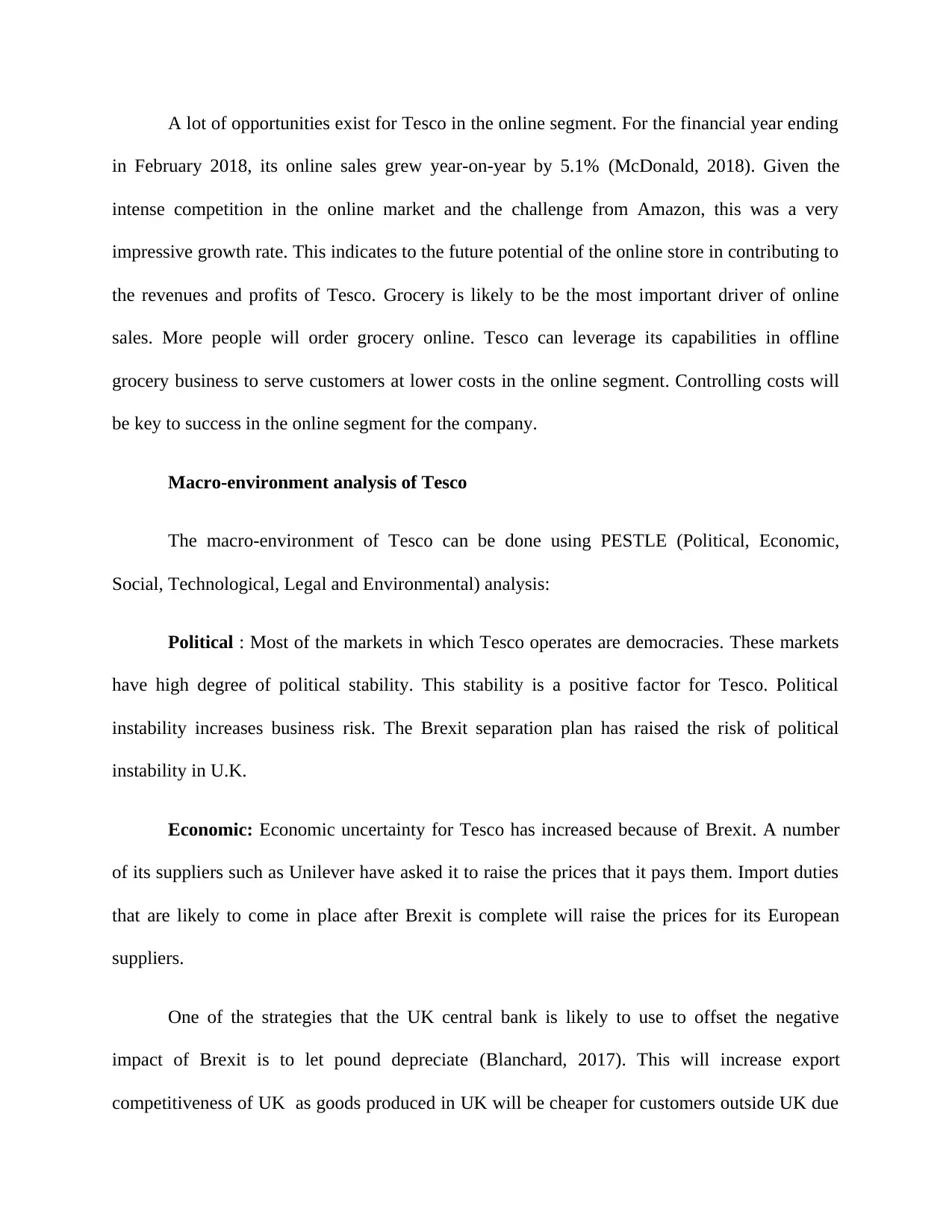
A lot of opportunities exist for Tesco in the online segment. For the financial year ending
in February 2018, its online sales grew year-on-year by 5.1% (McDonald, 2018). Given the
intense competition in the online market and the challenge from Amazon, this was a very
impressive growth rate. This indicates to the future potential of the online store in contributing to
the revenues and profits of Tesco. Grocery is likely to be the most important driver of online
sales. More people will order grocery online. Tesco can leverage its capabilities in offline
grocery business to serve customers at lower costs in the online segment. Controlling costs will
be key to success in the online segment for the company.
Macro-environment analysis of Tesco
The macro-environment of Tesco can be done using PESTLE (Political, Economic,
Social, Technological, Legal and Environmental) analysis:
Political : Most of the markets in which Tesco operates are democracies. These markets
have high degree of political stability. This stability is a positive factor for Tesco. Political
instability increases business risk. The Brexit separation plan has raised the risk of political
instability in U.K.
Economic: Economic uncertainty for Tesco has increased because of Brexit. A number
of its suppliers such as Unilever have asked it to raise the prices that it pays them. Import duties
that are likely to come in place after Brexit is complete will raise the prices for its European
suppliers.
One of the strategies that the UK central bank is likely to use to offset the negative
impact of Brexit is to let pound depreciate (Blanchard, 2017). This will increase export
competitiveness of UK as goods produced in UK will be cheaper for customers outside UK due
in February 2018, its online sales grew year-on-year by 5.1% (McDonald, 2018). Given the
intense competition in the online market and the challenge from Amazon, this was a very
impressive growth rate. This indicates to the future potential of the online store in contributing to
the revenues and profits of Tesco. Grocery is likely to be the most important driver of online
sales. More people will order grocery online. Tesco can leverage its capabilities in offline
grocery business to serve customers at lower costs in the online segment. Controlling costs will
be key to success in the online segment for the company.
Macro-environment analysis of Tesco
The macro-environment of Tesco can be done using PESTLE (Political, Economic,
Social, Technological, Legal and Environmental) analysis:
Political : Most of the markets in which Tesco operates are democracies. These markets
have high degree of political stability. This stability is a positive factor for Tesco. Political
instability increases business risk. The Brexit separation plan has raised the risk of political
instability in U.K.
Economic: Economic uncertainty for Tesco has increased because of Brexit. A number
of its suppliers such as Unilever have asked it to raise the prices that it pays them. Import duties
that are likely to come in place after Brexit is complete will raise the prices for its European
suppliers.
One of the strategies that the UK central bank is likely to use to offset the negative
impact of Brexit is to let pound depreciate (Blanchard, 2017). This will increase export
competitiveness of UK as goods produced in UK will be cheaper for customers outside UK due
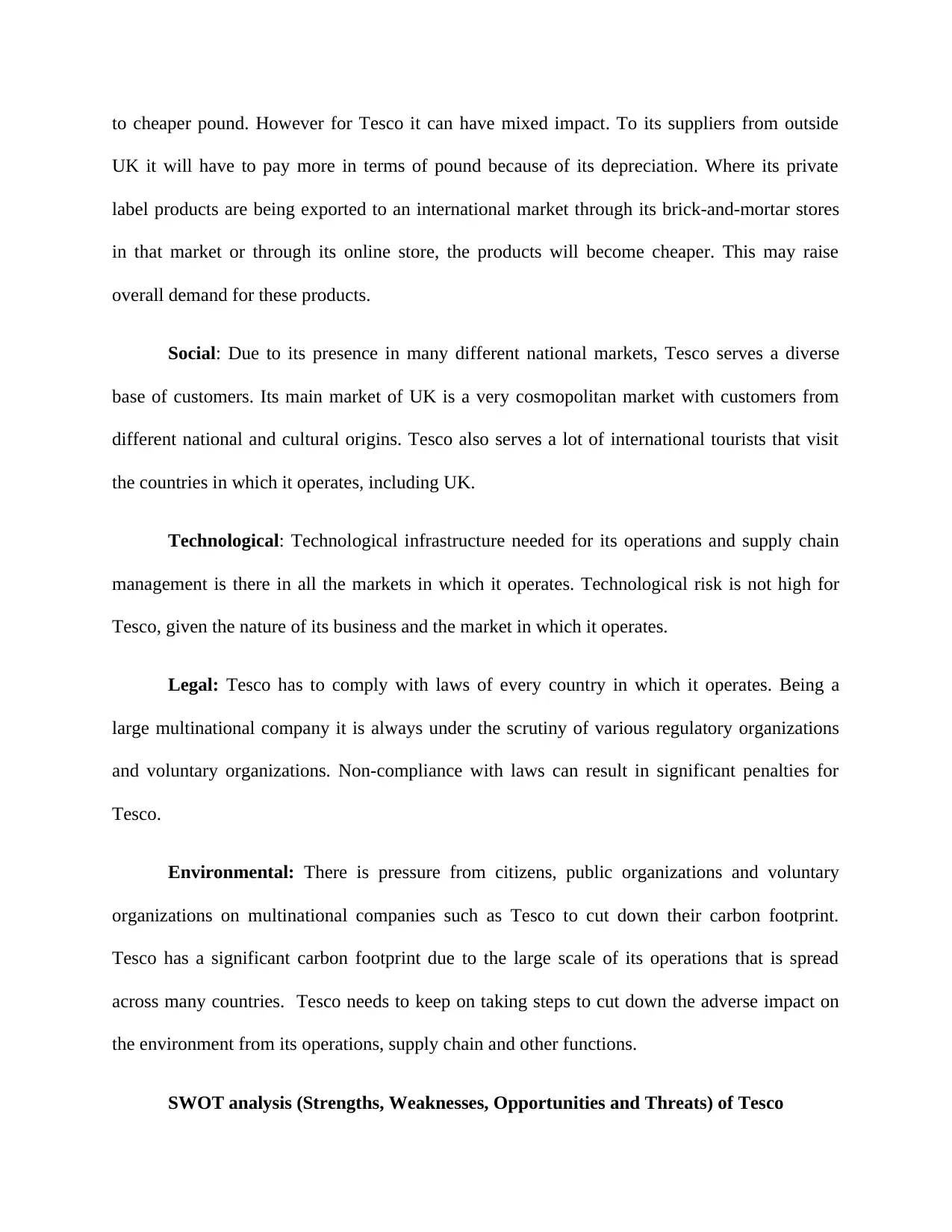
to cheaper pound. However for Tesco it can have mixed impact. To its suppliers from outside
UK it will have to pay more in terms of pound because of its depreciation. Where its private
label products are being exported to an international market through its brick-and-mortar stores
in that market or through its online store, the products will become cheaper. This may raise
overall demand for these products.
Social: Due to its presence in many different national markets, Tesco serves a diverse
base of customers. Its main market of UK is a very cosmopolitan market with customers from
different national and cultural origins. Tesco also serves a lot of international tourists that visit
the countries in which it operates, including UK.
Technological: Technological infrastructure needed for its operations and supply chain
management is there in all the markets in which it operates. Technological risk is not high for
Tesco, given the nature of its business and the market in which it operates.
Legal: Tesco has to comply with laws of every country in which it operates. Being a
large multinational company it is always under the scrutiny of various regulatory organizations
and voluntary organizations. Non-compliance with laws can result in significant penalties for
Tesco.
Environmental: There is pressure from citizens, public organizations and voluntary
organizations on multinational companies such as Tesco to cut down their carbon footprint.
Tesco has a significant carbon footprint due to the large scale of its operations that is spread
across many countries. Tesco needs to keep on taking steps to cut down the adverse impact on
the environment from its operations, supply chain and other functions.
SWOT analysis (Strengths, Weaknesses, Opportunities and Threats) of Tesco
UK it will have to pay more in terms of pound because of its depreciation. Where its private
label products are being exported to an international market through its brick-and-mortar stores
in that market or through its online store, the products will become cheaper. This may raise
overall demand for these products.
Social: Due to its presence in many different national markets, Tesco serves a diverse
base of customers. Its main market of UK is a very cosmopolitan market with customers from
different national and cultural origins. Tesco also serves a lot of international tourists that visit
the countries in which it operates, including UK.
Technological: Technological infrastructure needed for its operations and supply chain
management is there in all the markets in which it operates. Technological risk is not high for
Tesco, given the nature of its business and the market in which it operates.
Legal: Tesco has to comply with laws of every country in which it operates. Being a
large multinational company it is always under the scrutiny of various regulatory organizations
and voluntary organizations. Non-compliance with laws can result in significant penalties for
Tesco.
Environmental: There is pressure from citizens, public organizations and voluntary
organizations on multinational companies such as Tesco to cut down their carbon footprint.
Tesco has a significant carbon footprint due to the large scale of its operations that is spread
across many countries. Tesco needs to keep on taking steps to cut down the adverse impact on
the environment from its operations, supply chain and other functions.
SWOT analysis (Strengths, Weaknesses, Opportunities and Threats) of Tesco
⊘ This is a preview!⊘
Do you want full access?
Subscribe today to unlock all pages.

Trusted by 1+ million students worldwide
1 out of 15
Related Documents
Your All-in-One AI-Powered Toolkit for Academic Success.
+13062052269
info@desklib.com
Available 24*7 on WhatsApp / Email
![[object Object]](/_next/static/media/star-bottom.7253800d.svg)
Unlock your academic potential
Copyright © 2020–2025 A2Z Services. All Rights Reserved. Developed and managed by ZUCOL.



